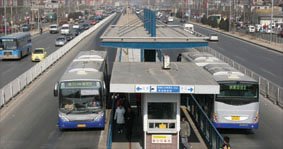 Metropolises like Beijing are growing fast. Traffic jams and smog are the order of the day. For two years now, traffic planners in Beijing have therefore been using Bus Rapid Transit (BRT) based on low-floor buses equipped with ZF technology.
Metropolises like Beijing are growing fast. Traffic jams and smog are the order of the day. For two years now, traffic planners in Beijing have therefore been using Bus Rapid Transit (BRT) based on low-floor buses equipped with ZF technology.
The benefits of the traffic concept are shorter implementation time, less space requirement at bus stops and greater flexibility. And often, this goes hand in hand with lower total costs compared to systems with platform bus stops. The benefits have been well recognised by many other cities worldwide like Istanbul, Teheran, Seoul, Santiago, Barquisimeto and Sao Paulo.Beijing was the first city to put a BRT bus line into service in 2006. Since then, approximately 10 more cities like Hangzhou have joined in.
The BRT concept with low-floor buses is implemented consistently everywhere: extra bus lanes, high frequencies and short dwell times at bus stops. Almost 90 state-of-the-art low-floor articulate buses are running on the roughly 16 km long north-south line in Beijing. They transport up to 160,000 passengers to their destination every day.
The use of low-floor buses enables level access for getting on and off the bus, also known as one-level boarding. The passengers can move through the bus quickly via the central corridor which is also free from platforms and steps. Thus, in Beijing, it is possible to achieve dwell times at bus stops of only about 16 seconds. In combination with extra bus lanes on the roads, the BRT line can serve the 17 bus stops in a three-minute cycle during the rush hour even in a 50-second interval.
Only 25 months’ planning, including all construction measures, and an investment cost of only $4.6 million per km were required for line operation in China’s capital. The time, effort and expenses were rather much less, mainly because it was not necessary to plan and build space-intensive platform bus stops.
ZF provides bus manufacturers worldwide with the technology for these low-floor buses. Mercedes-Benz, Setra, MAN, Neoplan, Scania, Volvo and many others are banking on ZF’s low-floor axle systems just like King Long, Dongfeng, Huanghai and Yutong.
In addition to the RL 85 A front axle, the AV 132 and AVN 132 portal axles as well as the RL 75 EC low-floor independent wheel suspension are made by ZF.
These products not only allow for low-floor technology but also ensure better manoeuvrability and handling, more driving and ride comfort, as well as increased safety. When combined with the automatic 6-speed transmission Ecomat 4, fuel consumption and emissions can be considerably reduced.
Beijing’s traffic planners are convinced of the BRT concept with low-floor buses. This year, and in time for the Olympic Games, two additional BRT lines will be put into service, also with low-floor buses. This shows that the low-floor concept is heading in the right direction.